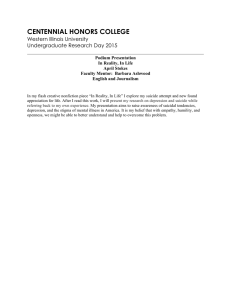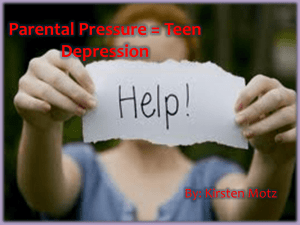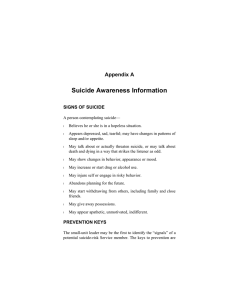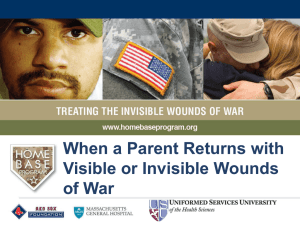LU Institute for Military Resilience Research “Summit” 9.21.12
advertisement
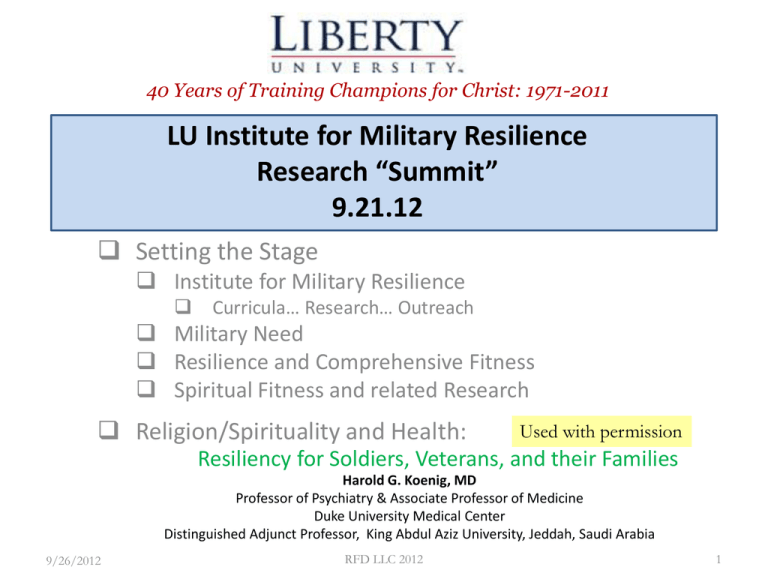
40 Years of Training Champions for Christ: 1971-2011 LU Institute for Military Resilience Research “Summit” 9.21.12 Setting the Stage Institute for Military Resilience Curricula… Research… Outreach Military Need Resilience and Comprehensive Fitness Spiritual Fitness and related Research Religion/Spirituality and Health: Used with permission Resiliency for Soldiers, Veterans, and their Families Harold G. Koenig, MD Professor of Psychiatry & Associate Professor of Medicine Duke University Medical Center Distinguished Adjunct Professor, King Abdul Aziz University, Jeddah, Saudi Arabia 9/26/2012 RFD LLC 2012 1 Liberty University Institute for Military Resilience (IMR) www.LUOnline.com/imr – Curriculum: (both undergrad & grad) NOTE: Liberty University has 25,000 Military Students with an inventory of over 150 programs of study – Resilient Warriors & Leaders – Resilient Military Marriage and Family – Military Transitions – Military Mental & Behavioral Health – More to Follow…. – Outreach New Programs focused on most challenging military issues of our day. • Existing Military Affairs Office activities • Share best practices nationwide • Faculty Orientations for Universities – Research • Integration and Assessment of Faith-Based Protocols RFD LLC 2012 2 “Our nation’s first faith-based program for Military Resilience.” 6.05.12 The Needs of the Hour PTSD/TBI Suicide Divorce Homelessness Drug/Alcohol Abuse Lawlessness Spouse Abuse Failure to Reintegrate 6.05.12 Isolation Incarceration Sexual Assault RFD LLC 2012 Child Abuse 3 RESILIENCE & Comprehensive Fitness U.S. Army -- Comprehensive Soldier Fitness A structured, long term assessment and development program to BUILD THE RESILIENCE and enhance the performance of every Soldier, Family member and DA civilian ARMY • • • • • Physical Family Social Emotional Spiritual Judeo Christian • • • • • U.S. Army Comprehensive Soldier Fitness (CSF) http://csf.army.mil 6.05.12 Physical (Strength) Mental (Mind) Social (“Neighbor”) Emotional (Heart) Spiritual (Soul) Holy Bible Great Commandment Mark 12:30,31 RFD LLC 2012 Marines • • • • • Physical Mental Social Emotional Spiritual Marine Operational Stress Surveillance and Training(MOSST) 4 Spiritual Fitness • Although there are no “silver bullets” to solve this challenge, there is an arena that has not been pursued to full extent: the faith factor related to Spiritual Fitness. • Faith is clearly a relevant dynamic (in society, and in the military demographic which is predominantly Christian) in the arenas of prevention and recovery from trauma (incl PTSD), marital/family cohesion, suicide prevention, and RESILIENCE. • If we are truly going to “get everything in the fight” on behalf of suicide prevention, we need to more robustly investigate and integrate the power of faith into a holistic and comprehensive approach. – This means we must include faith to “set conditions” for spiritual fitness “up stream” to create positive alternatives to suicide, as well as working the downstream symptoms. 6.05.12 RFD LLC 2012 5 Faith Makes a Difference in Suicide Risk & Prevention • • • • National studies demonstrated that non-participation in religious activities increased suicide risk by almost 400% (Comstock & Partridge, 1972; Nisbet et al, 2000) 57 of 68 studies (84%) that addressed the link between suicide and religion found that there were lower suicide rates among those more actively involved in faithbased activities (Koenig & Larsen, 2001) One landmark study discovered a link between religious beliefs and practices (specifically Christian), reduced rates of depression, and receiving religiouslyoriented cognitive behavioral therapy (Propst et al, 1992) – Participants showed reduced symptoms of post-treatment depression, balanced clinical adjustment, and lower recidivism with this mode of treatment Religion and spirituality have shown to reduce suicide rates for those suffering from Traumatic Brain Injury (Brenner et al, 2009) 6.05.12 Chaplains and faith-based counselors are uniquely qualified to serve a large segment of the military population—those who identify with a religious belief system—and especially those who carry the emotional RFD LLC 2012 and psychological wounds of war home with them. 6 Religion/Spirituality and Health: Resiliency for Soldiers, Veterans, and their Families Harold G. Koenig, MD Professor of Psychiatry & Associate Professor of Medicine Duke University Medical Center Distinguished Adjunct Professor, King Abdul Aziz University, Jeddah, Saudi Arabia Overview of Challenges Faced by Soldiers • High stress: before, during and after deployment • Poor health behaviors, difficulty with self-regulation • Alcohol and substance abuse • Fear, anger, violence • Isolation, lack of support (especially after return home) • Divorce, domestic abuse, sexual acting out • Depression, anxiety, PTSD • Lack of meaning, lack of hope, giving up: Suicide Religion and Successful Coping Religion is related to every one of the emotional and social challenges our soldiers face Religion and Psychological Stress Perceived Stress Watson et al (2002). Int’l J Psychology of Religion, 12(4), 255-276 (Iran & US) Pollard et al. (2004). Psychological Reports, 95(3,Part1), 999-1007 Maltby & (2004). Personality and Individual Differences, 36(6), 1275-1290 Steffen & Masters (2005). Annals of Behavioral Medicine, 30(3), 217-224. Cousson-Gelie et al. (2005). Psychological Reports, 97(3), 699-711 (breast CA) Michalsen et al. (2005). Medical Science Monitor, 11(12), CR555-561 Ng et al. (2005). Social Work in Health Care, 41(1), 33-52. Oman et al. (2006). Journal of Consulting & Clinical Psychology, 74(4), 714-719 Bowen et al. (2006). Depression and Anxiety, 23(5), 266-273 Dailey & Stewart (2007). Research in Nursing & Health 30, 61-71 General Stress Ferriss (2000). Social Indicators Research, 49(1), 1-23. Mahalik & Lagan (2001). Psychology of Men & Masculinity, 2, 24-33 Holland& Neimeyer (2005). Palliative and Supportive Care, 3(3), 173-181 Graham-Bermann et al. (2006). Violence Against Women, 12(7), 663-692 Kim et al. (2007). Supportive Care in Cancer 15(12), 1367-74 (caregiver) Pienaar et al. (2007). Criminal Justice and Behavior 34(2), 246-258 Religious Coping During National Stress America’s Coping Response to Sept 11th: 1. 2. 3. 4. 5. 6. Talking with others (98%) Turning to religion (90%) Checked safety of family/friends (75%) Participating in group activities (60%) Avoiding reminders (watching TV) (39%) Making donations (36%) Based on a random-digit dialing survey of the U.S. on Sept 14-16 New England Journal of Medicine 2001; 345:1507-1512 * Hundreds of quantitative and qualitative studies report similar findings in persons under stress, especially in minorities * How Religion Influences Coping 1. Positive world view 2. Meaning and purpose 3. Psychological integration 4. Hope (and motivation) 5. Personal empowerment 6. Sense of control (prayer) 7. Role models for suffering (facilitates acceptance) 8. Guidance for decision-making (reduces stress) 9. Answers to ultimate questions 10. Social support (both human and Divine) Not lost with physical illness or disability Does religion actually help people to cope better, or not The Research (systematic review 1872-2010 of all quantitative research published in peer reviewed academic scientific journals in the English language listed in PsychInfo and Medline) This research is documented in: Handbook of Religion and Health, (Oxford University Press, 2001) Handbook of Religion and Health, Second Edition (Oxford University Press, 2012) Research on Religion and Mental Health Emotional disorders Depression Suicide Substance use Positive emotions/virtues Well-being and happiness Meaning, purpose, and hope Forgiveness, altruism, gratitude, compassion Social health Social support Social capital Marital stability Emotional Disorders Depression (systematic review) Religious involvement is related to: Less depression, faster recovery from depression 272 of 444 studies (61%) [67% of best] More depression (6%) Religion and Depression in Hospitalized Patients Percent Depressed 35% 23% 22% 17% Low Moderate High Very High Degree of Religious Coping Geriatric Depression Scale Information based on results from 991 consecutively admitted patients (differences significant at p<.0001) Time to Remission by Intrinsic Religiosity (N=87 patients with major or minor depression by Diagnostic Interview Schedule) Probability of Non-Remission 100 % 80 Low Religiosity 60 Medium Religiosity 40 High Religiosity 20 0 0 10 20 30 Weeks of Followup American Journal of Psychiatry 1998; 155:536-542 40 50 Probability of Non-Remission 100% 845 medical inpatients > age 50 with major or minor depression 80 60 Other Patients 40 Highly Religious (14%) 20 HR=1.53, 95% CI=1.20-1.94, p=0.0005, after control for demographics, physical health factors, psychosocial stressors, and psychiatric predictors at baseline diagnosis 0 0 4 8 12 Weeks of Followup 16 20 24 Suicide (systematic review) Religious involvement is related to: Less suicide and more negative attitudes toward suicide 106 of 141 studies (75%) Anxiety and PTSD (systematic review) Religious involvement is related to: • Less anxiety, less PTSD (125 of 225 studies report significantly less) Spiritual Injury and PTSD Symptoms 1,385 veterans from Vietnam (95%), World War II and/or Korea (5%) involved in outpatient or inpatient PTSD programs. VA National Center for PTSD and Yale University School of Medicine. Weakened religious faith was an independent predictor of use of VA mental health services—independent of severity of PTSD symptoms and level of social functioning. Investigators concluded that the use of mental health services was driven more by their weakened religious faith than by clinical symptoms or social factors. Fontana, A., & R. Rosenheck. Trauma, change in strength of religious faith, & mental health service use among veterans treated for PTSD. Journal of Nervous & Mental Disease 2004; 192:579– 84. Positive Emotions / Virtues Well-being and Happiness (systematic review) Religious involvement is related to: Greater well-being and happiness 256 of 326 studies (79%) [82% of best] Lower well-being or happiness (<1%) Religion and Well-being in Older Adults Religion and Well-being in Older Adults The Gerontologist 1988; 28:18-28 Well-being Well-being The Gerontologist 1988; 28:18-28 Low Low Mode Mode rate rate High High Ve Ve ry ry High High Church Church Attendance Attendance or or Intrinsic Intrinsic Religiosity Religiosity Religious Religious categories categories based based on on quartiles quartiles (i.e., (i.e., low low is is 1st 1st quartile, quartile, very very high high is is 4th 4th quartile) quartile) Meaning, Purpose, Hope, Optimism (systematic review) Religious involvement is related to: Significantly greater meaning and purpose in life 42 of 45 studies (93%) [100% of best] Significantly greater hope 29 of 40 studies (73%) Significantly great optimism 26 of 32 studies (81%) Positive Human Virtues / Character Traits (systematic review) Religious involvement is related to: Significantly more forgiveness 34 of 40 studies (85%) [70% of best] Significantly more altruism / volunteering 33 of 47 studies (70%) [75% of best] Significantly more gratitude, compassion, kindness 8 of 8 studies (100%) Social Health Social Support (systematic review) Religious involvement is related to: Significantly greater social support 61 of 74 studies (82%) [93% of best] Social Capital (systematic review) Religious involvement is related to: Significantly greater social capital 11 of 14 studies (79%) Marital Stability (systematic review) Religious involvement is related to: Significantly greater marital stability 68 of 79 studies (86%) [92% of best] less divorce, greater marital satisfaction, less spousal abuse Poor Health Behaviors, Difficult with SelfRegulation Religious involvement is related to: • Less cigarette smoking, especially among the young 122 of 135 studies (90%) [90% of best] • Less extra-marital sex, safer sexual practices (fewer partners) 82 of 95 studies (86%) [84% of best] • Less alcohol use / abuse / dependence 240 of 278 studies (86%) [90% of best] • Less drug use / abuse / dependence 155 of 185 studies (84%) [86% of best] [95% experimental studies] Self-Regulation (cont) (systematic review) Religious involvement is related to: • Less anger, hostility (23 of 35 studies show significantly less) • Less delinquency and crime (81 of 102 studies show significantly lower rates) Religion and Physical Health 35 36 Serum IL-6 and Attendance at Religious Services (1675 persons age 65 or ov er liv ing in North Carolina, USA) Percent with IL-6 Levels >5 18 * bivariate analy ses ** analy ses controlled for age, sex, race, education, and phy sical functioning (ADLs) 16 14 12 10 8 6 Never/Almost Never 1-2/yr to 1-2/mo Once/wk or more Frequency of Attendance at Religious Services 37 chiatry in Medicine Citation: International Journal of Psy 1997; 27:233-250 Immune and Endocrine Functions (systematic review) Religious involvement is related to: Better immune functions (14 of 25 studies) (56%) Better endocrine functions (23 of 31 studies) (74%) (majority involving meditation) 38 Effects of Emotions on Cardiovascular Health • Blumenthal et al. Lancet 2003; 362:604-609 [817 undergoing CABG followed-up up for 12 years; controlling # grafts, diabetes, smoking, LVEF, previous MI, depressed patients had double the mortality] • Kubzansky et al. Arch Gen Psychiatry 2007; 64:1393-1401 [emotional vitality – positive emotions – reduces risk of coronary heart disease by nearly 20% over 15 years in over 6,000 persons] • Tindle HA et al. Circulation 2009; 120:656-662 [in a sample of 97,253 followed over 8 years (Women’s Health Initiative), cynical hostility associated with 13% increased risk of myocardial infarction and 25% increased risk of CHD mortality, as well as a 23% increased risk of cancer-related mortality; however, optimism was associated with a 16% reduction in risk of myocardial infarction, a 30% decrease in CHD mortality, and a 7% reduction in cancer-related mortality] 39 Cardiovascular Functions (systematic review) Religious involvement is related to: Lower blood pressure (36 of 63 studies) (57%) Better cardiovascular functions (CVR, HRV, CRP) (10 of 16 studies overall) (63%) Less coronary artery disease (12 of 19 studies overall) (63%) 40 Religious Activity and Diastolic Blood Pressure (n=3,632 persons aged 65 or over) Citation: International Journal of Psychiatry in Medicine 1998; 28:189-213 81 Average Diastolic Blood Pressure * Analy ses weighted & controlled for age, sex, race, smoking, education, phy sical functioning, and body mass index 80 79 p<.0001* 78 77 Low Attendance Low Prayer/Bible High Attendance Low Prayer/Bible Low Attendance High Prayer/Bible High = weekly or more for attendance; daily or more for prayer Low= less than weekly for attendance; less than 41 once/day for prayer High Attendance High Prayer/Bible Mortality From Heart Disease and Religious Orthodoxy (based on 10,059 civil servants and municipal employees) Most Orth odox Survival probability No Differences remain significant after controlling for blood pressure, diabetes, cholesterol, smoking, weight, and baseline heart disease n-B elie v ers Follow-up time, years Kaplan-Meier life table curves (adapted from Goldbourt et a l 1993. Cardiology 82:100-121) 42 Six-Month Mortality After Open Heart Surgery (232 patients at Dartmouth Medical Center, Lebanon, New Hampshire) 25 (10 of 49) % Dead 20 15 10 (2 of 25) (7 of 86) 5 (2 of 72) 0 Hi Religion Hi Soc Support Hi Religion Lo Soc Support 43 Lo Religion Hi Soc Support Lo Religion Lo Soc Support Mortality (all-cause) (systematic review) Religious involvement related to: • Greater longevity in 82 of 120 studies (68%) • Best studies (rated 8 or higher): 47 of 62 studies (76%) • Shorter longevity in 7 of 120 studies (6%) 44 The Relationship between Religion and Health: All Studies 2500 2000 C 1500 NG (NG) M (P) 1000 P NA 500 0 C NG (NG) M (P) P NA Number of studies includes some studies counted more than once (see Appendices of 1st and 2nd editi Prepared by Dr. Wolfgang v. Ungern-Sternberg Theoretical Model of Causal Pathways Private prac, rit Belief in, attachment to God Theological Virtues: faith, hope, love SOURCE R commitment R experiences faith community R coping Positive Emotions Psychological Traits / Virtues Forgiveness Honesty Courage Self-discipline Altruism Humility Gratefulness Patience Dependability Social Connections Negative Emotions Mental Disorders Genetics, Developmental Experiences, Personality *Model for Western monotheistic religions (Christianity, Judaism, and Islam) Physical Health and Longevity Public prac, rit Immune, Endocrine, Cardiovascular Functions Decisions, Lifestyle Choices, Health Behaviors Spirituality faith community (c) Handbook of Religion & Health, 2nd ed Summary • For some, particularly active duty soldiers, veterans, and their families, religion can be a powerful coping resource • Religion is related to better mental health and better health behaviors • Religion is related to better physical health, medical and surgical outcomes, and greater longevity • We cannot ignore this powerful resource for resiliency at a time like this Further Reading 1. Spirituality in Patient Care (Templeton Press, 2007) (clinician) 2. Healing Power of Faith (Simon & Schuster, 2001) (patient) 3. Medicine, Religion and Health (Templeton Press, 2008) (patient/clinician) 4. Spirituality and Health Research: Methodology, Measurement, Analyses, and Resources (Templeton Press, 2011) (researcher) 5. Handbook of Religion and Health (Oxford University Press, 2001; and Second Edition, 2012) (clinician and researcher) 6. In the Wake of Disaster (Templeton Press, 2007) Summer Research Workshop July 16-20 and August 13-17, 2012 Durham, North Carolina 5-day intensive research workshops focus on what we know about the relationship between spirituality and health, applications, how to conduct research and develop an academic career in this area. Leading spirituality-health researchers at Duke, UMSC, and elsewhere will give presentations: -Strengths and weaknesses of previous research -Theological considerations and concerns -Highest priority studies for future research -Strengths and weaknesses of measures of religion/spirituality -Designing different types of research projects - Primer on statistical analysis of religious/spiritual variables -Carrying out and managing a research project -Writing a grant to NIH or private foundations -Where to obtain funding for research in this area -Writing a research paper for publication; getting it published -Presenting research to professional and public audiences; working with the media Scholarships are available for the financially destitute If interested, contact Harold G. Koenig: koenig@geri.duke.edu Discussion (till 1:00)
